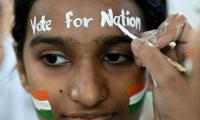Pakistan follows an electoral system known as the ‘First-Past-The-Post (FPTP)’ system. Under this system, the leading political party may secure less than 50 percent of the votes and still manage to form the government. Thus, the party forming the government may not be the true representative of the majority of the electorate.
For example, in the last two general elections for the National Assembly (NA), the PML-N (2013) and the PTI (2018) won 33 percent and 32 percent of votes respectively and yet were able to form majority governments by bringing in independent winning candidates and MNAs from various regional parties. In simpler terms, it means that every two out of three of those people who cast their votes did not vote for the party that eventually formed the government in both 2013 and 2018.
In 2013, the PML-N – despite receiving only about 33 percent of the total votes cast that year – ended up with 49 percent of the total seats in the NA. Similarly, in the last elections the PTI received about 32 percent of the votes and ended up with 44 percent of seats in the NA. This disproportionality is a direct consequence of the ‘First-Past-The-Post’ system that the country follows. The current system allows only for single-member constituencies with plurality voting – only one member per each constituency with most votes is elected to the legislature.
The current system is one that the country inherited upon its independence from the British Empire, and it is largely owing to convention that the country has persisted with its use. While it is true that some of the countries that were traditionally part of the British Empire still maintain the FPTP/Plurality system, the system has been replaced by a majority of countries worldwide which instead implement varying forms of more proportional systems.
Proponents of the FPTP system often cite the fact that one significant advantage that this system has is its simplicity in both understanding and implementation as compared to the various forms of proportional electoral system. They argue that for a proportional system to be effectively adopted the population needs to be highly literate, something that is not the ground reality in Pakistan. This view however is not entirely true as there are many proportional systems that are not convoluted and hold the key towards electing governments that are representative and truly reflect the collective will of the electorate. One such system is called ‘ranked-choice voting’ in which instead of the candidate winning the most votes getting elected, a candidate has to gain majority vote (at least 50 percent) in order to get elected from the constituency.
As opposed to the FPTP system, in which the candidate with the most votes at the end of the count is declared the winner, in a ranked-choice system a candidate must gain the majority vote. Voters in the ranked-choice system are asked to rank the candidates in their order of preference. Once all voters have voted, the votes are counted taking into counting consideration the first choice of all voters. If at this stage a candidate gets the majority vote (usually 50 percent), they are declared the winner. However, if no candidate gets a majority vote after this first exercise, the candidate with the least number of votes at this stage is dropped from the count and the second choice candidate on those ballots is allocated those votes respectively. The iterative process continues until a candidate with majority vote emerges.
The Ranked-Choice system through a clever ranking system combined with recounting means that the winning candidate for a constituency has through an indirect method a claim to be being elected by the majority of the electorate. This then on a macro-level translates into parties being selected with a higher number of aggregate votes which are more in line with the resulting percentage seats that are allocated to them in the legislature.
The Ranked-Choice system is just one example of several different systems that can be used to elect more representative governments that are proportionally in line with the actual number of votes that respective competing parties gain. There are other systems that can be considered that might serve the purpose through simpler processes.
Another additional possibility that should potentially be explored is to introduce multi-member constituencies instead of the current single-member constituencies. There is a plausible argument to be had: that those constituencies that have markedly more number of total votes should have the provision of multiple winning candidates being selected to the legislature.
Changes in the electoral system will not be easy to introduce and will initially require considerable political and institutional will. Nevertheless, once the electorate has been trained and a proportional system implemented, the country will benefit from having representative governments. Time and again in Pakistan has it been observed that the people quickly get disappointed with elected governments, leading to various forms of non-democratic means including ‘street-politics’ employed by political parties not in government.
The fact that the current system allows for a party for which every two in three voters have not voted is one of the causes of such disappointment. A proportional system for elected constituencies will be a significant step towards representative governments that reflect the collective will of the electorate.
Raja Rafi is a research fellow at PIDE. Email: rafiullah@pide.org.pk
Nadeem Ul Haque is vice chancellor of PIDE.
A woman walks past a building of the International Monetary Fund. — AFP/FileThe annual and spring meetings of the...
Late Benazir Bhutto's daughter Asifa Bhutto Zardari addresses the Christian community in Bihar Colony on January 23,...
Representational image. — PexelsWater is an important scarce natural resource that is required for several everyday...
Pakistani employees of online marketplace company Kaymu at work in Karachi. — AFP/FileThe true spirit of development...
India uses Afghanistan as a backstage area to carry out terrorist attacks against Pakistan
Another report by the Pakistan Institute of Peace Studies states that 78 per cent of attacks have been carried out by...







